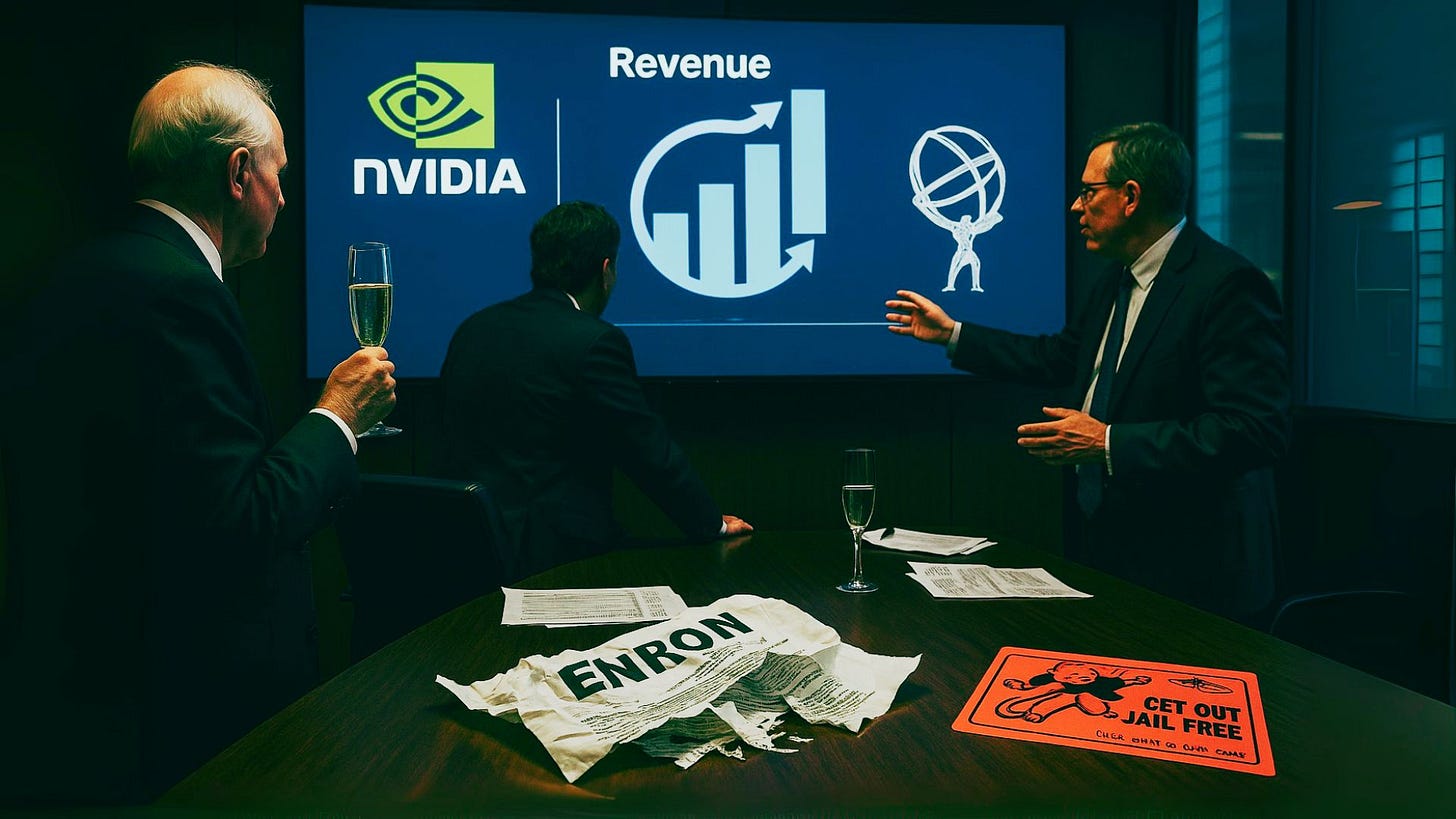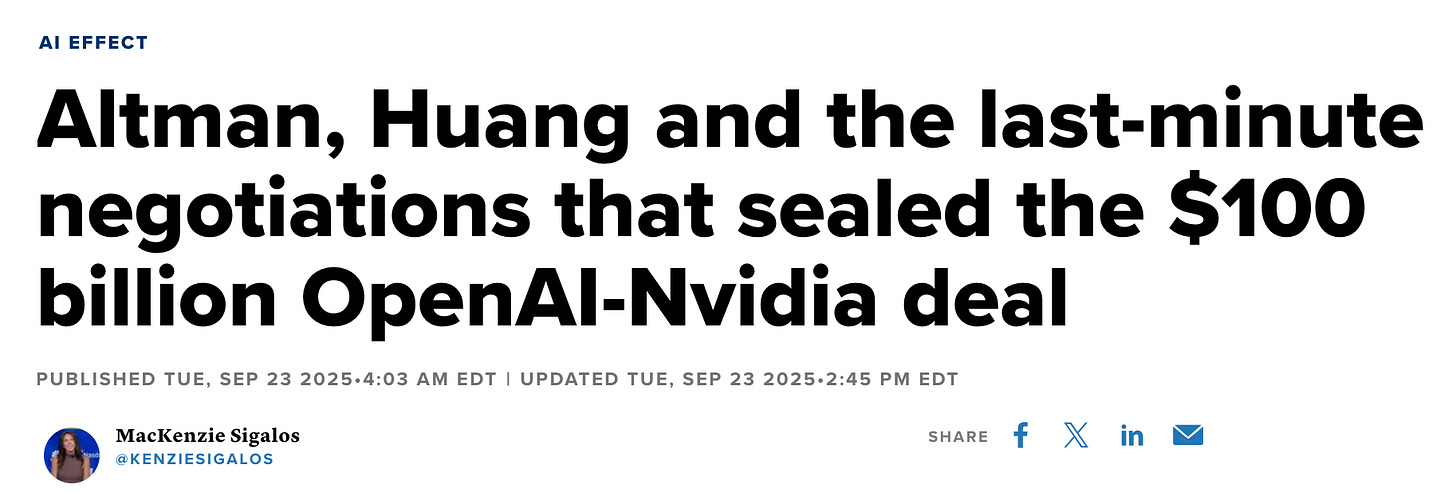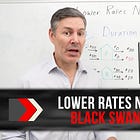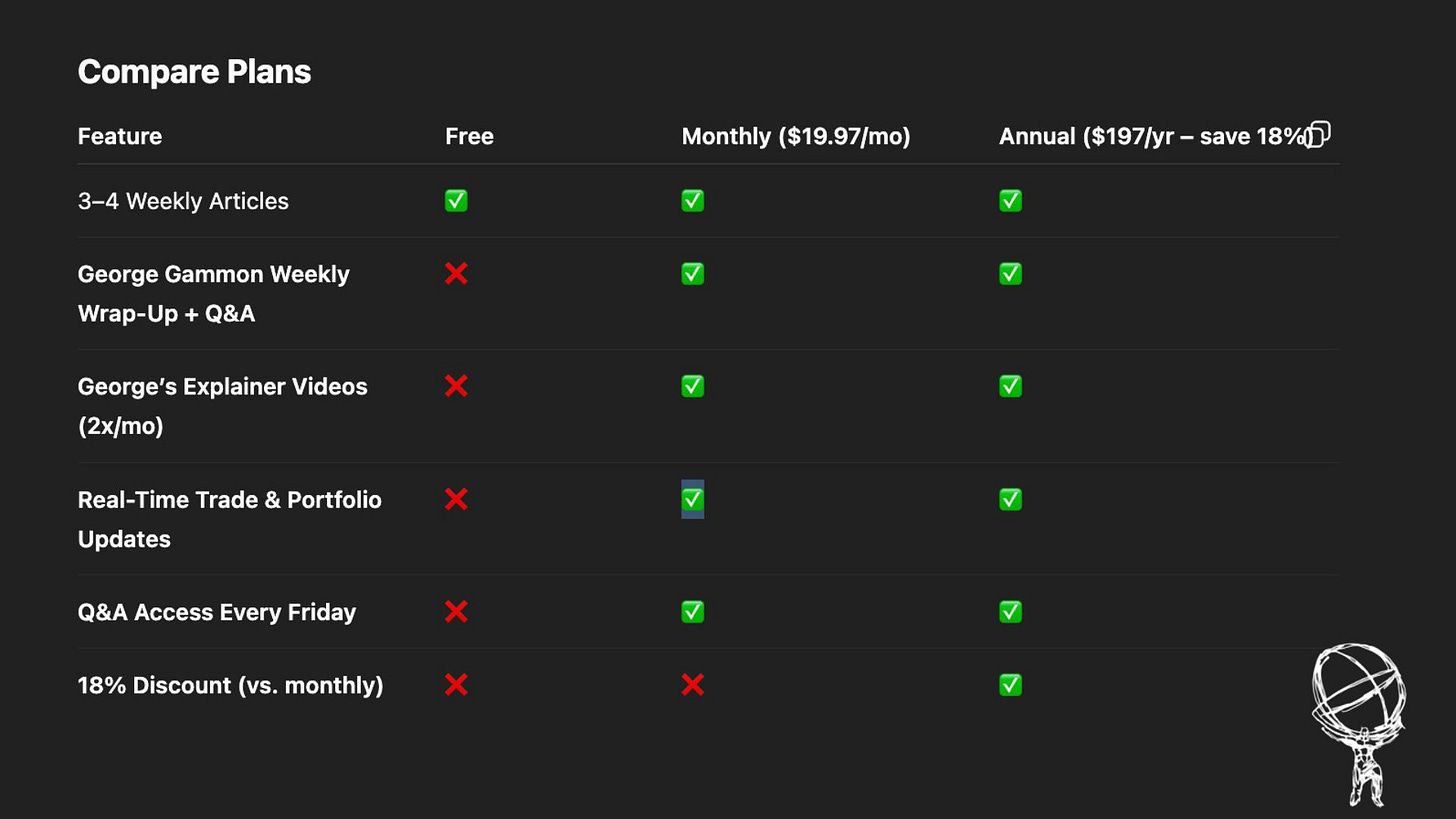Round-Tripping, Cronyism, and the AI Bubble
The Political Moat Propping Up Big Tech
Rebel Capitalist AI | Supervision and Topic Selection by George Gammon | September 24, 2025
The biggest tech story this week isn’t a new chip, app, or chatbot. It’s a $100 billion deal between Nvidia and OpenAI…a deal that smells a whole lot like financial engineering, corporate cronyism, and maybe even 21st-century Enron.
Let’s unpack the mechanics of the Nvidia–OpenAI deal, explore how similar “round-tripping” arrangements fueled past financial blowups, and most importantly, show why this could be a flashing red light for investors in the AI bubble.
First: What the Hell Is Going On?
Nvidia just “invested” $100 billion into OpenAI. Sounds bullish, right?
Until you realize: OpenAI is Nvidia’s customer.

That $100 billion will…directly or indirectly…be spent on Nvidia GPUs.
So Nvidia is essentially giving OpenAI money that OpenAI turns around and gives right back.
That’s not investment. That’s a revenue round-trip.
And guess what? Nvidia can now record $100 billion in “sales,” juicing its top line and boosting its valuation by multiples of that amount.
It’s like a landlord giving their kid $200 to pay $200 in rent…and then using that rent to claim the basement is worth $2400.
This isn’t capitalism. It’s clown world financial alchemy.
But before you dismiss this as a one-off gimmick, remember: we’ve seen this movie before…and the ending is rarely happy for investors.
The Playbook: From Gold Miners to Crypto to AI
Let’s not kid ourselves…this isn’t new. Junior gold miners pulled this trick for decades.
So did the crypto cowboys of 2020–2022.
Now, the tech elite have taken that same playbook, added a trillion-dollar price tag, and sprinkled it with some high-level political access.
The only difference?
The scale is bigger.
The players are more powerful.
And the collusion with government is front and center.
Which raises the uncomfortable question: how much of Nvidia’s revenue is real, and how much is smoke and mirrors?

Nvidia’s “Sales” Are a Mirage
Strip away these round-tripping deals and ask yourself: what would Nvidia’s sales really be?
How much of their current revenue is from customers they’ve directly funded or propped up?
What happens when the illusion cracks — and the market realizes that much of Nvidia’s explosive revenue growth is artificial?
You don’t need to be a forensic accountant to see the parallels here to Enron, Global Crossing, and other past implosions.
It’s the same trick, just with different packaging.
And if history is any guide, the packaging doesn’t matter…the collapse looks the same.
What’s Round-Tripping…and Why It’s Potentially Illegal
According to ChatGPT itself (yes, we checked):
“Revenue round-tripping is an accounting trick where Company A sells to Company B and buys from B in return, inflating top-line sales despite no real economic activity.”
In other words, fake revenue.
Enron did this with energy contracts. Global Crossing did it with bandwidth swaps. Both went to zero.
Is it legal? Sometimes…but only if there’s real economic substance. In Nvidia’s case, that’s a big question mark.
And the higher the valuation climbs on these “sales,” the more catastrophic the fallout when regulators, markets, or reality finally catch up.
Cronyism on Steroids
The most alarming part? The tight entanglement between these companies and the U.S. government.
Nvidia CEO Jensen Huang and OpenAI CEO Sam Altman joined Donald Trump on a state visit to the UK.
They negotiated this $100 billion deal during that trip — without bankers.
Oracle, another major player, just signed a $300 billion compute deal with OpenAI and is co-investing in Trump’s “Stargate” AI initiative.
The government just bought 10% of Intel… then Nvidia announced a $5 billion investment in Intel days later.
This isn’t free market capitalism. It’s a merger of corporate and state power — what Mussolini would’ve called you-know-what-ism.
And when the state and corporations blur into one, investors need to ask: are we analyzing businesses… or are we betting on political favoritism?
Why This Is Dangerous for Markets
This level of incest between Big Tech and Big Government creates several critical risks:
Distorted Capital Allocation
Money flows to politically connected firms, not those creating the most value.Fake Valuations Fuel Bubbles
Artificially inflated revenues drive inflated share prices, creating unsustainable valuations.Barriers to Entry Skyrocket
Visa fees and regulation are weaponized to crush startups, locking in monopoly power for incumbents.Price Discovery Dies
If these companies’ revenues are looped and manipulated, how can investors know what they’re actually worth?Moral Hazard Goes Nuclear
When firms realize government partnerships = profit guarantees, the incentive to innovate vanishes.
Put simply: once markets stop serving as a truth-detector, they start serving as a propaganda tool…and that’s when bubbles turn deadly.
This Isn’t Just “Capitalism Gone Wrong”
It’s something else entirely…and we need to define our terms clearly.
What we’re seeing is not capitalism.
It’s crony capitalism. Corporatism. The same government-business merger that destroyed innovation in past empires.
And the danger is that regular people…your neighbors, the public…will see this corruption and say, “Capitalism doesn’t work.” But this isn’t capitalism. It’s a perversion of it.
That’s why we at Rebel Capitalist always say:
“Stand up for free-market capitalism…not capitalism without limits.”
But defining the disease is only step one. The real test is exposing how the scam actually functions in practice.
The $100 Billion Shell Game…Step by Step
Let’s map it out:
Nvidia gives $100B to OpenAI
→ Looks like a big investment.OpenAI buys Nvidia chips with that money
→ Nvidia books massive revenue.Revenue multiple pushes Nvidia’s market cap up by $500B+
→ Jensen gets richer by doing nothing.OpenAI uses new valuation to raise more money at inflated prices
→ Rinse and repeat.Retail chases the hype
→ FOMO drives prices even higher.
Meanwhile, there’s little to no real profitability behind these moves. OpenAI still loses money. Nvidia’s revenue is, at best, partially fabricated. And everyone’s lining up at the government trough.
It’s a flywheel of illusion…but flywheels spin until friction stops them.
The only question is: what sparks the stall?
The “Moat” Is Politics, Not Product
Another critical piece here is immigration.
Trump recently proposed a $100,000 visa fee…on H1B-style talent.
Who does that hurt?
Not Nvidia. Not OpenAI. Not Oracle. They can afford it.
It hurts startups…the next-gen competitors that might actually innovate.
So what do Sam and Jensen do? They join Trump in London. They wine and dine him. They get the favor…and the moat grows.
And when moats are built with political concrete instead of product excellence, you know disruption has been locked out of the room.
What This Means for AI Investors
Let’s be clear: AI is real. It’s transformative. It’s powerful.
But that doesn’t mean it’s profitable.
In fact, AI may turn out to be a commodity…with little moat, constant price compression, and limited stickiness.
If that’s true, the current AI valuations are not just high…they’re hallucinatory.
Just like the 3D printing boom. Or the NFT craze. Or fiber optic cable in 1999.
So while the headlines scream “innovation,” the smart money is whispering “bubble.”
Trade Ideas: If the AI Bubble Pops
1. Short Overhyped AI Stocks
Especially those with questionable revenue sources or incestuous funding loops.
2. Long Gold and Silver
As faith in tech narratives erodes, real assets shine.
3. Long Anti-Bubble Plays (e.g., Uranium, Commodities)
Non-correlated, real-world businesses will outperform.
4. Long Select Emerging Markets
Countries with real growth and less political capture could outperform.
5. Long Volatility (VIX Calls, Tail Hedges)
When bubbles pop, they pop fast.
Watch What They Do, Not What They Say
When CEOs are spending more time at state dinners than in data centers…
When companies record record sales by giving customers money to spend with them…
When government and corporate power merge into one indistinguishable blob…
You know the endgame isn’t far off.
These aren’t the signals of sustainable innovation. They’re the last gasp of a rigged system that’s turning inward, protecting itself, and inflating its own importance at your expense.
As investors, we have to stay sharp. Because while everyone else is buying the hype, the smart money is preparing for the bust.
The only question left is: will you be on the right side of the trade when the bubble pops?
This Nvidia–OpenAI deal isn’t just a quirky accounting trick.
It’s a blueprint for how the biggest players are gaming markets with government help…and how fragile this AI bubble really is.
The question is: will you get caught holding the bag when the illusion cracks?
That’s exactly why we built the Rebel Capitalist News Desk. Every week, George Gammon and the team break down the hidden mechanics Wall Street and Washington don’t want you to see…from financial engineering schemes to geopolitical shocks.
👉 Join thousands of contrarian investors already preparing for what comes next. Get George’s weekly wrap-up after market close, subscriber-only whiteboard videos, and exclusive trade ideas that cut through the noise.
Don’t just read the headlines. Understand the game. Upgrade to the Rebel Capitalist News Desk today.















Excellent analysis. I smell bubbles. It seems buying gold shows up on every recent article. I agree. When this bubble explodes no asset except gold will be immune.
As to this quote ““Stand up for free-market capitalism…not capitalism without limits.”
Capitalism with limits is democratic socialism. Free-market capitalism doesn’t work. It always implodes. It leads to bubble inflation, bursting bubbles, wars, record wealth inequality, corruption and political capture. We are seeing all that in abundance with AI and the tech bros. I fail to see how it ends differently this time.